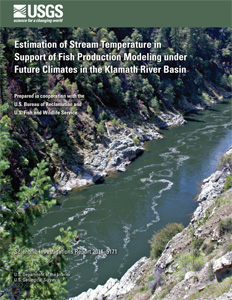 Abstract Abstract
Stream temperature estimates under future climatic conditions were needed in support of fish production modeling for evaluation of effects of dam removal in the Klamath River Basin. To allow for the persistence of the Klamath River salmon fishery, an upcoming Secretarial Determination in 2012 will review potential changes in water quality and stream temperature to assess alternative scenarios, including dam removal. Daily stream temperature models were developed by using a regression model approach with simulated net solar radiation, vapor density deficit calculated on the basis of air temperature, and mean daily air temperature. Models were calibrated for 6 streams in the Lower, and 18 streams in the Upper, Klamath Basin by using measured stream temperatures for 1999–2008. The standard error of the y-estimate for the estimation of stream temperature for the 24 streams ranged from 0.36 to 1.64°C, with an average error of 1.12°C for all streams. The regression models were then used with projected air temperatures to estimate future stream temperatures for 2010–99. Although the mean change from the baseline historical period of 1950–99 to the projected future period of 2070–99 is only 1.2°C, it ranges from 3.4°C for the Shasta River to no change for Fall Creek and Trout Creek. Variability is also evident in the future with a mean change in temperature for all streams from the baseline period to the projected period of 2070–99 of only 1°C, while the range in stream temperature change is from 0 to 2.1°C. The baseline period, 1950–99, to which the air temperature projections were corrected, established the starting point for the projected changes in air temperature. The average measured daily air temperature for the calibration period 1999–2008, however, was found to be as much as 2.3°C higher than baseline for some rivers, indicating that warming conditions have already occurred in many areas of the Klamath River Basin, and that the stream temperature projections for the 21st century could be underestimating the actual change.
|
First posted March 9, 2012
Part or all of this report is presented in Portable Document Format (PDF); the latest version of Adobe Reader or similar software is required to view it. Download the latest version of Adobe Reader, free of charge. |